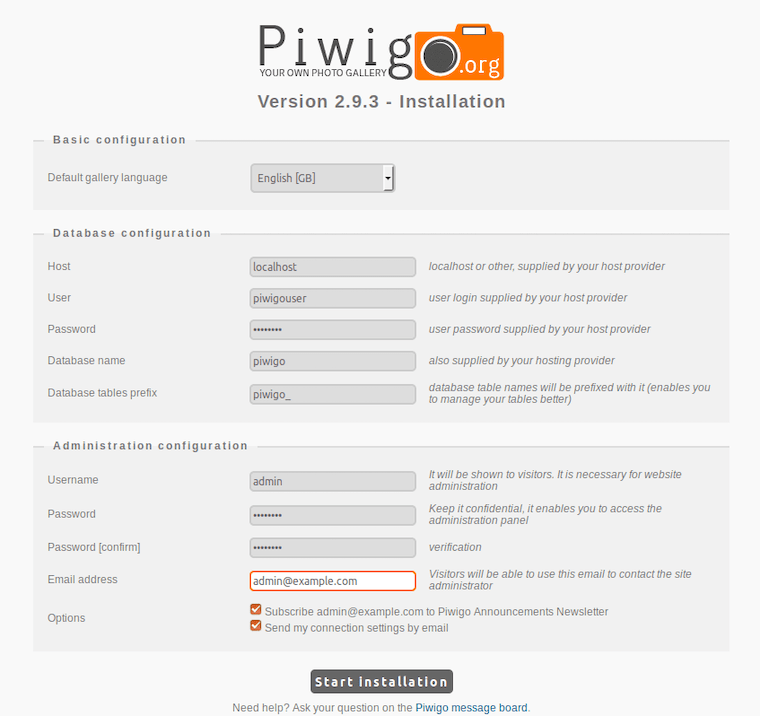
In this tutorial, we will show you how to install Piwigo on CentOS 8. For those of you who didn’t know, Piwigo is a free, open-source, and photo gallery software built on the LAMP stack. It supports multiple media formats, integrated blogs, and custom pages. Piwigo is an ideal CMS tool for photographers, designers, filmmakers, and musicians.
This article assumes you have at least basic knowledge of Linux, know how to use the shell, and most importantly, you host your site on your own VPS. The installation is quite simple and assumes you are running in the root account, if not you may need to add ‘sudo‘ to the commands to get root privileges. I will show you the step-by-step installation of Piwigo Photo Gallery on CentOS 8.
Prerequisites
- A server running one of the following operating systems: CentOS 8.
- It’s recommended that you use a fresh OS install to prevent any potential issues.
- SSH access to the server (or just open Terminal if you’re on a desktop).
- A
non-root sudo useror access to theroot user. We recommend acting as anon-root sudo user, however, as you can harm your system if you’re not careful when acting as the root.
Install Piwigo on CentOS 8
Step 1. First, let’s start by ensuring your system is up-to-date.
sudo dnf install epel-release sudo dnf update
Step 2. Installing a LAMP server.
A CentOS 8 LAMP server is required. If you do not have LAMP installed, you can follow our guide here.
Step 3. Installing Piwigo on CentOS 8.
Now we download a Piwigo package from the official website using wget command:
curl -o piwigo.zip http://piwigo.org/download/dlcounter.php?code=latest
Next, unzip the downloaded file with the following command:
unzip piwigo.zip mv piwigo /var/www/html/piwigo
We will need to change some folders permissions:
chown -R www-data:www-data /var/www/html/piwigo/ chmod -R 755 /var/www/html/piwigo/
Step 4. Configuring MariaDB for Piwigo.
By default, MariaDB is not hardened. You can secure MariaDB using the mysql_secure_installation script. you should read and below each step carefully which will set a root password, remove anonymous users, disallow remote root login, and remove the test database and access to secure MariaDB:
mysql_secure_installation
Configure it like this:
- Set root password? [Y/n] y - Remove anonymous users? [Y/n] y - Disallow root login remotely? [Y/n] y - Remove test database and access to it? [Y/n] y - Reload privilege tables now? [Y/n] y
Next, we will need to log in to the MariaDB console and create a database for Piwigo. Run the following command:
mysql -u root -p
This will prompt you for a password, so enter your MariaDB root password and hit Enter. Once you are logged in to your database server you need to create a database for Piwigo installation:
MariaDB [(none)]> create database piwigo_db; MariaDB [(none)]> create user piwigo_user@localhost identified by 'your-unique-passwd'; MariaDB [(none)]> grant all privileges on piwigo_db.* to piwigo_user@localhost identified by 'Passw0rd@123'; MariaDB [(none)]> flush privileges; MariaDB [(none)]> exit;
Step 5. Configuring Apache.
Now we create an Apache virtual host configuration file for Moodle with the following command:
nano /etc/httpd/conf.d/piwigo.conf
Add the following lines:
<VirtualHost *:80> ServerAdmin admin@piwigo.idroot.us ServerName piwigo.idroot.us DocumentRoot /var/www/html/piwigo DirectoryIndex index.php <Directory /var/www/html/piwigo/> Options Indexes FollowSymLinks MultiViews AllowOverride All Order allow,deny allow from all </Directory> ErrorLog /var/log/httpd/piwigo_error.log CustomLog /var/log/httpd/piwigo_access.log combined </VirtualHost>
Save and close the file. Restart the apache service for the changes to take effect:
sudo systemctl restart httpd
Step 6. Set up an SSL certificate.
First, download the required packages and create a new system binary:
wget https://dl.eff.org/certbot-auto sudo mv certbot-auto /usr/local/bin/certbot-auto sudo chown root /usr/local/bin/certbot-auto sudo chmod 0755 /usr/local/bin/certbot-auto
Next, run the certbot command that will download and install all of its dependencies:
sudo /usr/local/bin/certbot-auto --apache
Step 7. Configure Firewall.
Modify firewall rules in order to allow web access:
sudo firewall-cmd --zone=public --permanent --add-service=http sudo firewall-cmd --zone=public --permanent --add-service=https sudo firewall-cmd --reload
Step 8. Accessing Piwigo Web Interface.
Piwigo will be available on HTTP port 80 by default. Open your favorite browser and navigate to https://piwigo.idroot.us. On the first installation screen, select Piwigo language and insert MySQL database settings: host, user, password, and table prefix. Also, add a Piwigo admin account with a strong password and the email address of the admin account. Finally, hit on the Start installation button to install Piwigo.

Congratulations! You have successfully installed Piwigo. Thanks for using this tutorial to install the Piwigo Photo Gallery on CentOS 8 system. For additional help or useful information, we recommend you to check the official Piwigo website.